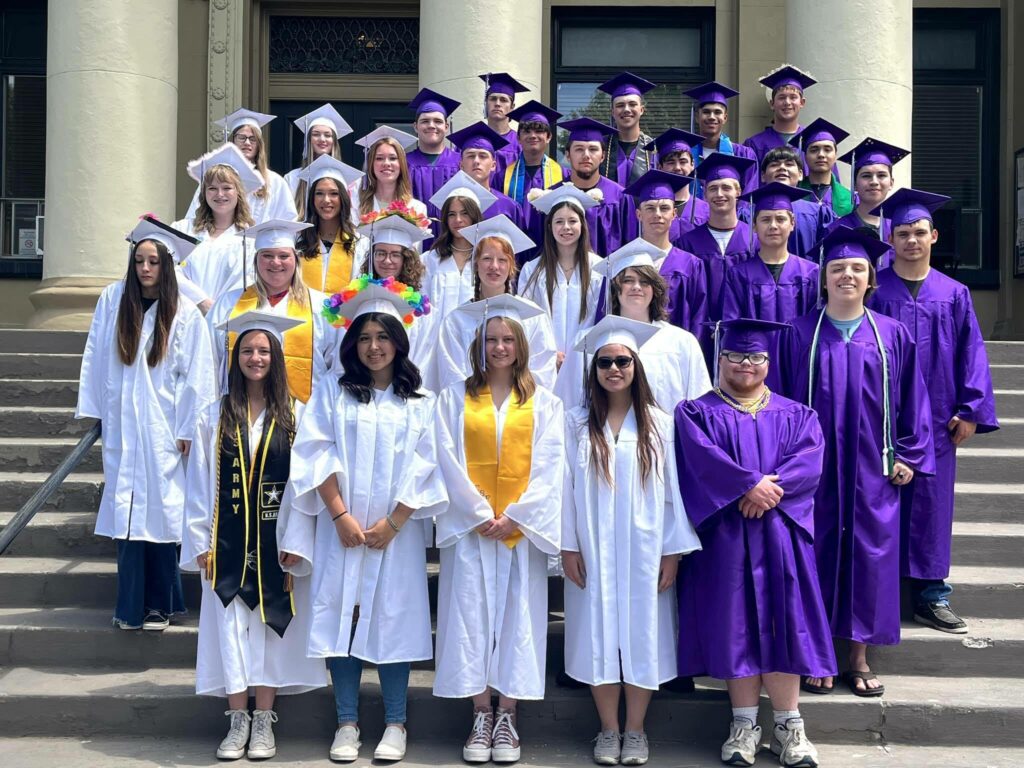
Modoc High School’s 2023 graduating class.
Credit: Modoc Joint Unified / Facebook
Modoc Joint Unified School District Superintendent Tom O’Malley always tells people one thing to describe rural Alturas: It’s 100 miles from the nearest Walmart.
A big grocery store isn’t the only thing missing, though. Nestled in the northeastern corner of the state with a population of about 2,700, Alturas is also 205 miles from the nearest four-year university, California State University, Chico, and 90 miles from the nearest community college, Shasta College Intermountain Campus.
That distance can often make it difficult for Modoc High School’s 233 students to even dream about attending college after graduation. O’Malley and his staff at MJUSD are trying to change that.
According to Modoc High School’s counselor, Candace Boudreaux, the number of students enrolling in four-year colleges after graduation has been increasing in recent years. The most recent data from National Student Clearinghouse shows Modoc has seen a steady increase in students enrolling in college any time during their first two years after high school, climbing from 50% in 2017 to 63% in 2021.
Especially for rural students, it’s not just about enrolling in university, but about remaining there until graduation, which can be more difficult for students from low-income and/or first-generation backgrounds who often lack the necessary resources to make it through college. At Modoc, 62.7% of students are considered socioeconomically disadvantaged, according to the school’s 2021 School Accountability Report Card.
For those attending four-year institutions, Modoc has seen 100% of students who enrolled in college during the first year after high school remain enrolled for a second year, according to data from 2020.
Boudreaux said she thinks this success is due to a number of factors, including pushing students to fulfill all A-G requirements — a set of minimum courses required for admission at California public colleges — as well as requiring students to fill out the FAFSA, the federal student aid application.
Taking them on college campus visits is an additional priority because of the location hurdle. This, paired with a dual-enrollment program with nearby colleges that help students feel equipped to take on college-level courses when they graduate, can make the idea of attending university seem more achievable.
It’s not only the logistical components that matter at Modoc though. According to Boudreaux, having a strong support system for students at school is also key, especially for first-generation students who may feel lost during the college application process.
“The support at school in a rural high school is really important because I feel like that’s where they’re not hearing it being pushed anywhere else,” Boudreaux said.
Kristen Budmark, principal of Modoc High School, said being a small school is a benefit in terms of capacity to support students.
“We will continue to do what’s best for our students, whatever their life path may be,” she said. “As a small school, we are able to tailor that plan individually to each student, and we fully immerse ourselves in their lives.”

Credit: Courtesy of Linda Plumlee
Linda Plumlee, a recent graduate of Modoc High.
For recent Modoc graduate Linda Plumlee, this support at school was vital to her success. Plumlee, who will be attending UC Berkeley this fall with a number of scholarships — including $30,000 from the McConnell Scholars Program — has been living on her own since the age of 14, and was emancipated from her parents at 15.
Plumlee had to support herself financially through high school, while balancing classes and extracurricular activities like cheer and Future Farmers of America. She’s worked a number of jobs to keep herself afloat, including as a ranch hand, housekeeper, waitress and more.
It was a former counselor at Modoc who led her to an opportunity at TEACH, a community-based nonprofit she’s been working for since her first year in high school.
Besides financial obstacles, Plumlee said Alturas’ location was also a barrier to pursuing higher education. She explained that being far from college campuses made it difficult to decide where to apply, and added pressure because she was having to choose between colleges she’d never visited.
Plumlee credits her success to help from Modoc staff like Boudreax, along with support from her friends and the entire Alturas community.
“I’ve been helped so much in this community in tremendous ways,” Plumlee said.
Plumlee will be studying marine biology at UC Berkeley, and while she’s nervous about making the jump from a town of 2,700 to a city of over 100,000, she’s looking forward to the adventure.
“I’m just super excited to be somewhere where there’s just so much life to see and experience,” she said.
Despite the barriers that come with living in a rural area, Plumlee said she’s grateful for the experience and the community she calls home.
“I think the support that you get from a small community is not something you ever see in those bigger cities,” she explained. “Sometimes you hear people say that ‘you don’t have as many opportunities or you don’t get access to as much,’ which can be super true. But I also feel like it goes both ways. In big cities — those kids don’t get access to the things and opportunities that we have here either.”

